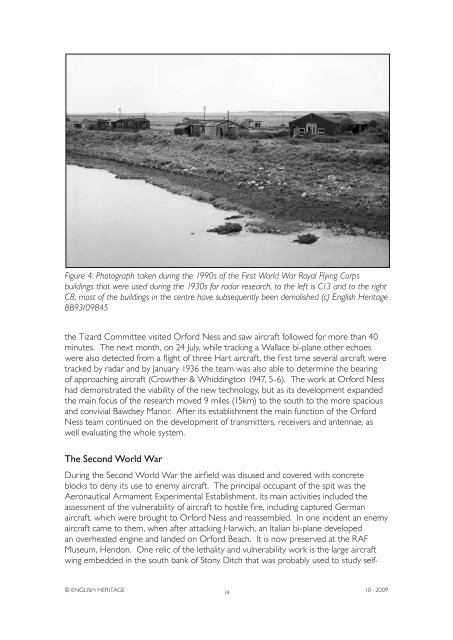Atomic Weapons Research Establishment. Orford ... - English Heritage
Atomic Weapons Research Establishment. Orford ... - English Heritage
Atomic Weapons Research Establishment. Orford ... - English Heritage
You also want an ePaper? Increase the reach of your titles
YUMPU automatically turns print PDFs into web optimized ePapers that Google loves.
Figure 4: Photograph taken during the 1990s of the First World War Royal Flying Corps<br />
buildings that were used during the 1930s for radar research, to the left is C13 and to the right<br />
C8, most of the buildings in the centre have subsequently been demolished (c) <strong>English</strong> <strong>Heritage</strong><br />
BB93/09845<br />
the Tizard Committee visited <strong>Orford</strong> Ness and saw aircraft followed for more than 40<br />
minutes. The next month, on 24 July, while tracking a Wallace bi-plane other echoes<br />
were also detected from a flight of three Hart aircraft, the first time several aircraft were<br />
tracked by radar and by January 1936 the team was also able to determine the bearing<br />
of approaching aircraft (Crowther & Whiddington 1947, 5-6). The work at <strong>Orford</strong> Ness<br />
had demonstrated the viability of the new technology, but as its development expanded<br />
the main focus of the research moved 9 miles (15km) to the south to the more spacious<br />
and convivial Bawdsey Manor. After its establishment the main function of the <strong>Orford</strong><br />
Ness team continued on the development of transmitters, receivers and antennae, as<br />
well evaluating the whole system.<br />
The Second World War<br />
During the Second World War the airfield was disused and covered with concrete<br />
blocks to deny its use to enemy aircraft. The principal occupant of the spit was the<br />
Aeronautical Armament Experimental <strong>Establishment</strong>, its main activities included the<br />
assessment of the vulnerability of aircraft to hostile fire, including captured German<br />
aircraft, which were brought to <strong>Orford</strong> Ness and reassembled. In one incident an enemy<br />
aircraft came to them, when after attacking Harwich, an Italian bi-plane developed<br />
an overheated engine and landed on <strong>Orford</strong> Beach. It is now preserved at the RAF<br />
Museum, Hendon. One relic of the lethality and vulnerability work is the large aircraft<br />
wing embedded in the south bank of Stony Ditch that was probably used to study self-<br />
© ENGLISH HERITAGE<br />
14<br />
10 - 2009

















